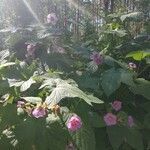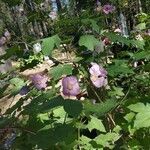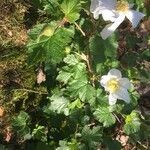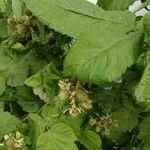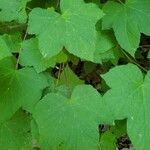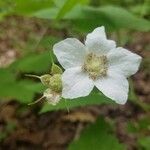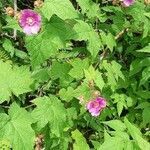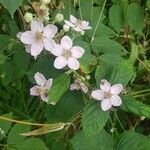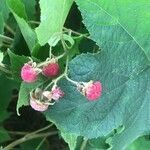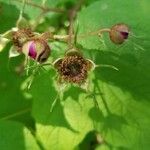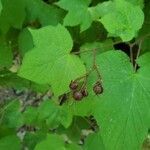Shrubs, 10–20 dm, unarmed. Stems erect, sparsely to moderately hairy, moderately to densely stipitate-glandular, ?glands dark purple?, not pruinose. Leaves deciduous, simple; stipules lanceolate to ovate, 5–15 mm; blade subrotund to reniform, 9–20(–30) × (10–)15–25(–30) cm, base cordate, palmately, ± deeply, (3–)5-lobed, margins finely, irregularly serrate to doubly serrate, apex acute to acuminate, abaxial surfaces sparsely to moderately hairy, sparsely to densely stipitate-glandular, ?glands dark purple?. Inflorescences terminal and axillary, 4–7(–22)-flowered, cymiform to thyrsiform. Pedicels pubescent, moderately to densely stipitate-glandular, ?glands dark purple?. Flowers bisexual; petals usually magenta, rarely white, broadly obovate to suborbiculate, (12–)17–25(–30) mm; filaments filiform; ovaries distally densely hairy, ?styles clavate, glabrous?. Fruits pale to dark red, hemispheric, 0.7–1.5 cm; drupelets 30–60, coherent, separating from torus. 2n = 14.
More
Widely branched unarmed shrub 1–2 m, becoming densely and coarsely glandular above; lvs subrotund to triangular or reniform in outline, 1–2 dm wide, (3)5-lobed a half or a third their length; the lobes triangular, acute, irregularly serrate; fls rose-purple (white), in a loose, open, widely branched cyme; sep with ± dense purple elongate gland-tipped hairs or bristles; pet obovate, 1.5–2.5 cm; fr depressed, 1 cm thick, dryish and rather insipid, the drupelets tending to fall separately; 2n=14. Moist, shady places and margins of woods; N.S. and Me. to Mich., s. to N.C. and Tenn. June–Aug. (Rubacer o.)
A tall bramble. It loses its leaves during the year. The flowers are deep pink-purple. The fruit are flattish.
Moist thickets and woodland borders. Moist shady sites in deciduous forests, margins of woods, rocky slopes, wooded talus, stream banks, roadsides; at elevations up to 1,500 metres.
Can be grown by divisions or seedlings. Seeds needs stratification.
